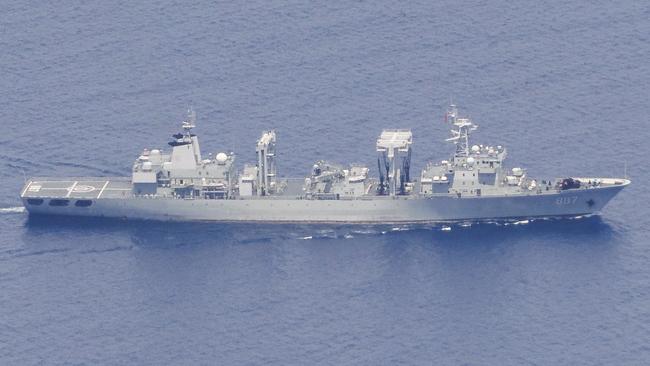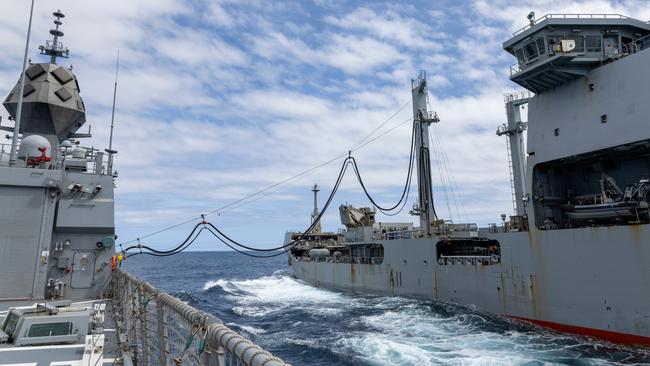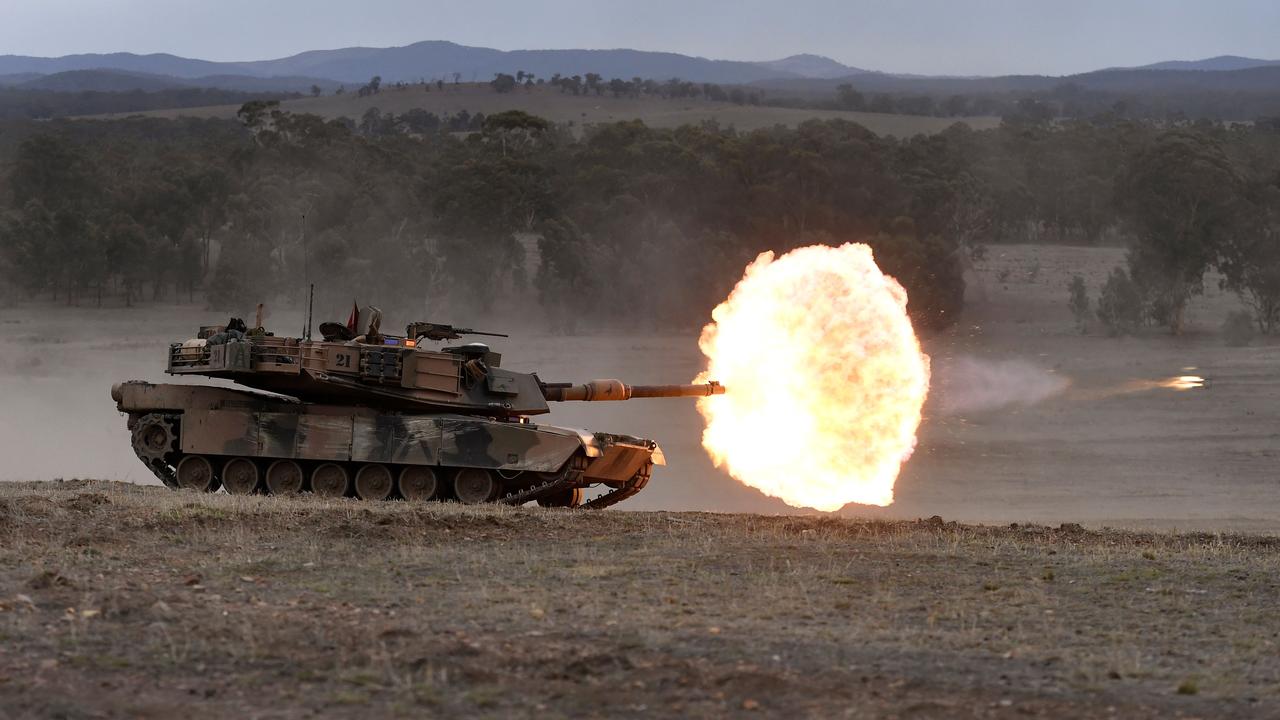China’s lap of Australia to test the navy’s stamina
The expected circumnavigation of Australia by three Chinese warships will test the navy’s ability to maintain constant surveillance of the vessels, experts warn.

The expected circumnavigation of Australia by three Chinese warships will test the navy’s ability to maintain constant surveillance of the vessels, experts warn, because its two new tanker ships are both out of action with defective drive shafts.
Amid mounting pressure on the Albanese government over the Chinese flotilla’s live weapons drills last week, former home affairs secretary Mike Pezzullo urged a “full classified report” to determine the adequacy of Australia’s response.
The call came as Defence Minister Richard Marles slapped down one of his senior officials on Friday after he suggested a decision on the navy’s Anzac-class replacement frigates could be delayed until next year, slowing the rejuvenation of the surface fleet.
As of Friday, the People’s Liberation Army-Navy ships were 320 nautical miles (593km) south-southwest of Adelaide and on course to do a lap of the continent, raising fresh questions over the navy’s ability to shadow them.
“I think that the circumnavigation might test us,” former naval officer Jennifer Parker said.
“The real issue for us here is the availability of surface combatants to maintain presence for a lengthy period, and the availability of tankers to replenish those surface combatants.”
The Chinese task group includes the Fuchi-class replenishment vessel, Weishanhu, giving it the ability to operate independently of local ports.

But the Australian navy’s auxiliary oilers, HMAS Supply and HMAS Stalwart, have been out of service for 23 months and nine months respectively, forcing its warships to rely on the fuel they can carry before heading to the nearest port. HMAS Stuart was refuelled in recent days by New Zealand’s Polar-class sustainment ship HMNZS Aotearoa, due to the lack of Australian replenishment vessels.
Ms Parker said relying on New Zealand’s support in the Tasman Sea wasn’t a problem, “but as (the Chinese ships) circumnavigate Australia – because we don’t have that replenishment capability right now – it is more difficult for our warships to stay on station”.
Another former navy officer, who declined to be identified due to the sensitivity of information on naval capabilities, said shadowing the Chinese vessels over the roughly 2000 nautical mile stretch from Perth to Darwin would present the biggest challenge, due to the lack of major port infrastructure along the west and northwest coastlines.
The former commander said a Western Australia-based ship would likely have to head into the Great Australian Bight to start tailing the Chinese vessels.
“You’re following the whole way with one eye on the fuel gauge, because, you know you don’t have a tanker anywhere nearby,” he said.
An Anzac-class frigate has a range of 6000 nautical miles at 18 knots, but burns fuel much more quickly at higher speeds.
The former officer said the Chinese could lead the tailing ship on a high-speed chase into the Indian Ocean and back to deplete its fuel reserves. “Our lack of replenishment ships means we are tied by a chain to refuel in ports. The Chinese have a replenishment ship. They are tied to that.”
The government has been on the back foot all week over its response to the Chinese flotilla, after it emerged Defence only learned of its live-fire drill on Friday 40 minutes after the exercise window opened thanks to a warning relayed by a Virgin Australia pilot. New Zealand passed on a second warning 50 minutes later from one of its frigates that Australia was relying on to monitor the Chinese vessels.
The revelations, from Defence officials, contradicted Anthony Albanese’s version of events, who said China provided notice of the drill “in accordance with practice”, and the two warnings came through “at about the same time”.
Defence Industry Minister Pat Conroy hit back at opposition criticism of the government’s handling of the episode, insisting the flotilla had faced “the highest level of surveillance that you’ve ever seen from the Australian Defence Force for a cruise in international waters near Australia”.
Mr Pezzullo said: “If that is unprecedented surveillance, then that might not be sufficient.”
He said the government needed to quickly do a “lessons learned” exercise. “My view is that there should be a full classified report now prepared, with potentially a public version, of the timeline, and any inadequacies and deficiencies – some of that you might not want to publicise – with the aim of figuring out how we do this better next time,” Mr Pezzullo said.

Opposition foreign affairs spokesman David Coleman said Mr Albanese had misled the public on the warnings received.
“The government has to tell the truth to the Australian people. What the government’s … trying to do here is say there’s nothing to see here, and plainly there is something to see here,” he said.
As the Chinese flotilla exposes years of under-investment in the Australian naval fleet, Mr Marles bristled at comments by a senior official in Senate estimates this week that a decision on the nation’s new general-purpose frigates was not due until the first quarter of next year.
Defence Department deputy secretary Jim McDowell said this was an “aggressive” timeframe given such decisions typically took seven to 10 years. But the government had already said a decision between Japan’s upgraded Mogami frigate and Germany’s Meko A-200 would be made by the end of the year.
Mr Marles said on Friday he would not tolerate any delays.
“We want to see a decision made this year, so let me be clear about that,” he said.
“Our No.1 objective here is speed into service. What came out of the surface fleet review (released last year) was really a need to get more surface combatants into service in the Royal Australian Navy as quickly as possible.”
The Prime Minister reiterated on Friday that Beijing should have provided greater notice of its live-fire drills on Friday and Saturday, which caused dozens of flights between Australia and New Zealand to have to alter their flight plans.
But Chinese ambassador Xiao Qian said his country felt no need to apologise for the conduct of its vessels, and warned Australia to expect more such voyages.
“As a major power in this region, as a country that has so many things to look after, it is normal for China to send their vessels to different parts of the region to conduct various kinds of activities,” Mr Xiao told the ABC.
HMAS Supply is undergoing repairs at Sydney’s Fleet Base East and is not scheduled to return to service until at least the middle of the year. HMAS Stalwart has recently undergone repairs but has not yet returned to service.







To join the conversation, please log in. Don't have an account? Register
Join the conversation, you are commenting as Logout